The claim that half the corals of the Great Barrier Reef are dead is based on a new method using ‘proxies’ (not a direct measure of coral cover), applied to badly cyclone damaged reefs, just after a major coral bleaching event – from which the corals have since recovered.
It has been reported across the world yet again, that the reef is ruin, but none of the publications reporting its demise have bothered to actually send journalists to go and look. They trust the scientists and the journal. Yet Terry Hughes, one of the authors of the new article has been shown time and again to just make stuff up when it comes to the health of individual coral reefs. His research centre (ARC Centre of Excellence for Coral Reef Studies) and the journal that published the most recent article claiming half the coral are dead (London’s Royal Society) have been mired in controversy for years.
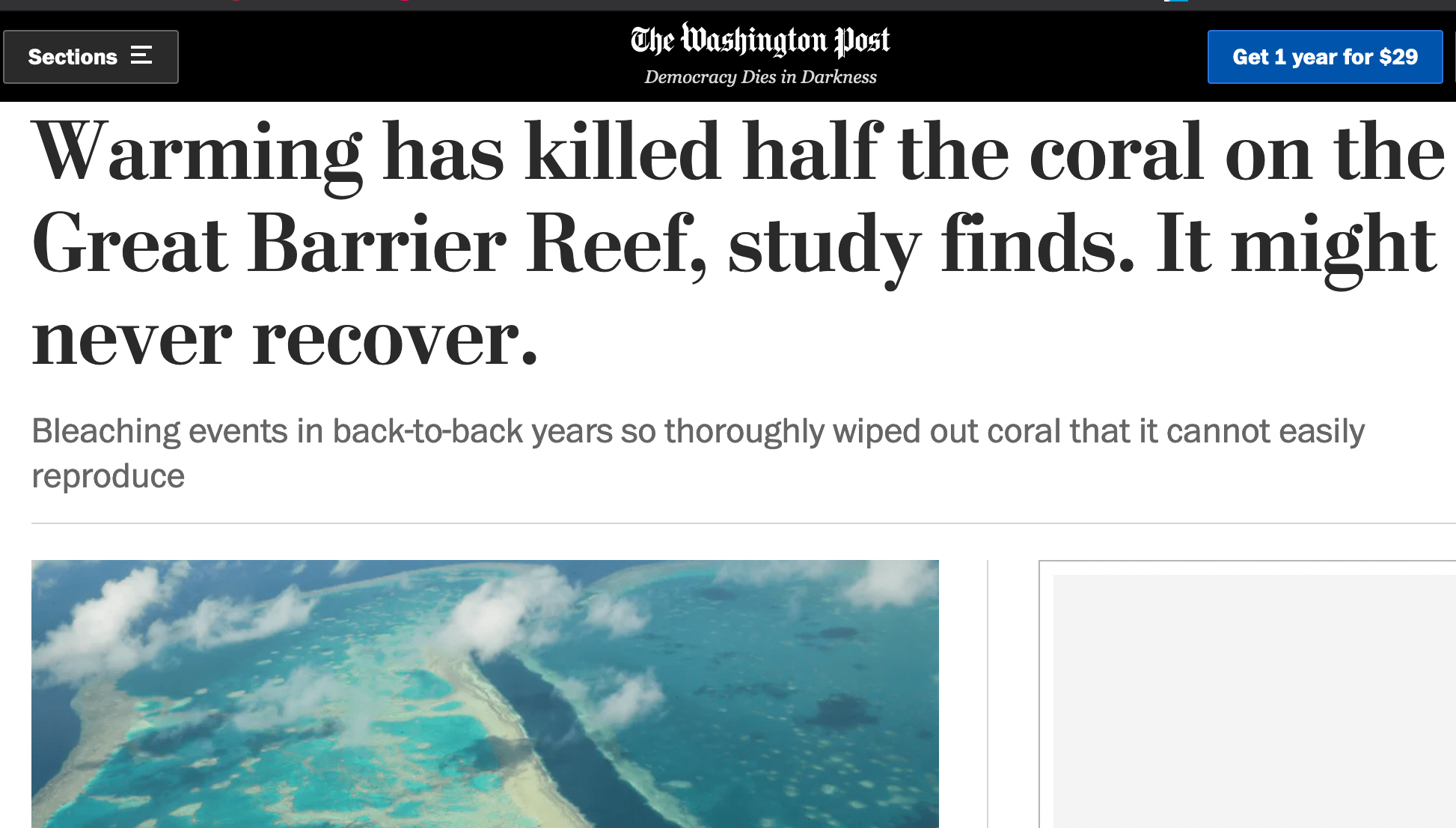
____________________________
One of the locations mentioned in the new study is in the far northern section, at North Direction Island. The coral reefs around this small, uninhabited steep granite island have been through the eye of some of the most destructive category 4 and 5 cyclones — Ita in 2014 and Nathan in 2015 — and they were at the centre of the coral bleaching event in the summer of 2016. But the coral reefs there have since recovered.
I dived nearby reefs for a week earlier this year. I went to the Ribbon reefs that follow the edge of Australia’s continental shelf in the far north east to find, and film, coral bleaching.
It is claimed the Ribbon reefs are amongst the worst affected – 60% dead from bleaching. Bleaching is when corals turn white as a result of warmer water temperatures, which climate scientists say is being caused by global warming.
But I couldn’t find any significant bleaching. I mostly found jewelled curtains of coral, appearing to cascade down underwater cliff faces. So colourful, so beautiful, all in crystal clear and warm waters with curious clownfish and a giant potato cod.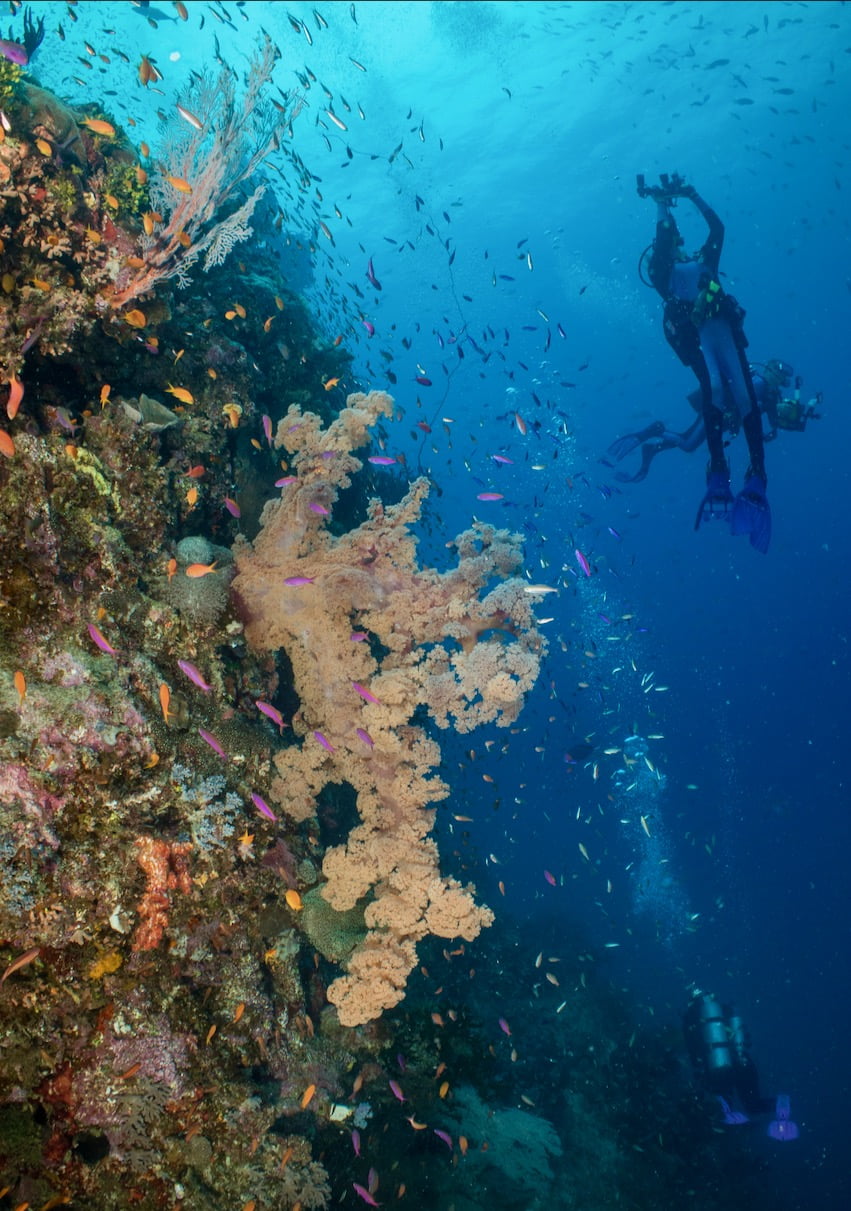
I found the 2,000-year old coral colony known as The Monolith. This is perhaps the largest colony of Pavona clavus coral in the world. I was told by the boat skipper that The Monolith had been badly bleached in 2016. It had fully recovered when I was filmed swimming over it in January 2020. I was filmed by Emmy award winning underwater cinematographer Clint Hempsall.
A study published by Reef Check Australia, undertaken between 2001 to 2014 – where citizen scientists followed an agreed and straightforward methodology at 77 sites on 22 reefs – concluded that 43 sites showed no net change in hard coral cover, 23 sites showed an increase by more than 10 per cent (10–41 per cent, net change), and 17 sites showed a decrease by more than 10 per cent (10–63 per cent, net change). This study was undertaken just before the 2016 bleaching event.
While the new article by the James Cook University scientists, claims both the incident of coral bleaching and cyclones is increasing, there is actually no evidence to support either contention.
The available data (1971 to 2017) indicates there has actually been a decrease in both the number and severity of cyclones in the Australian region.
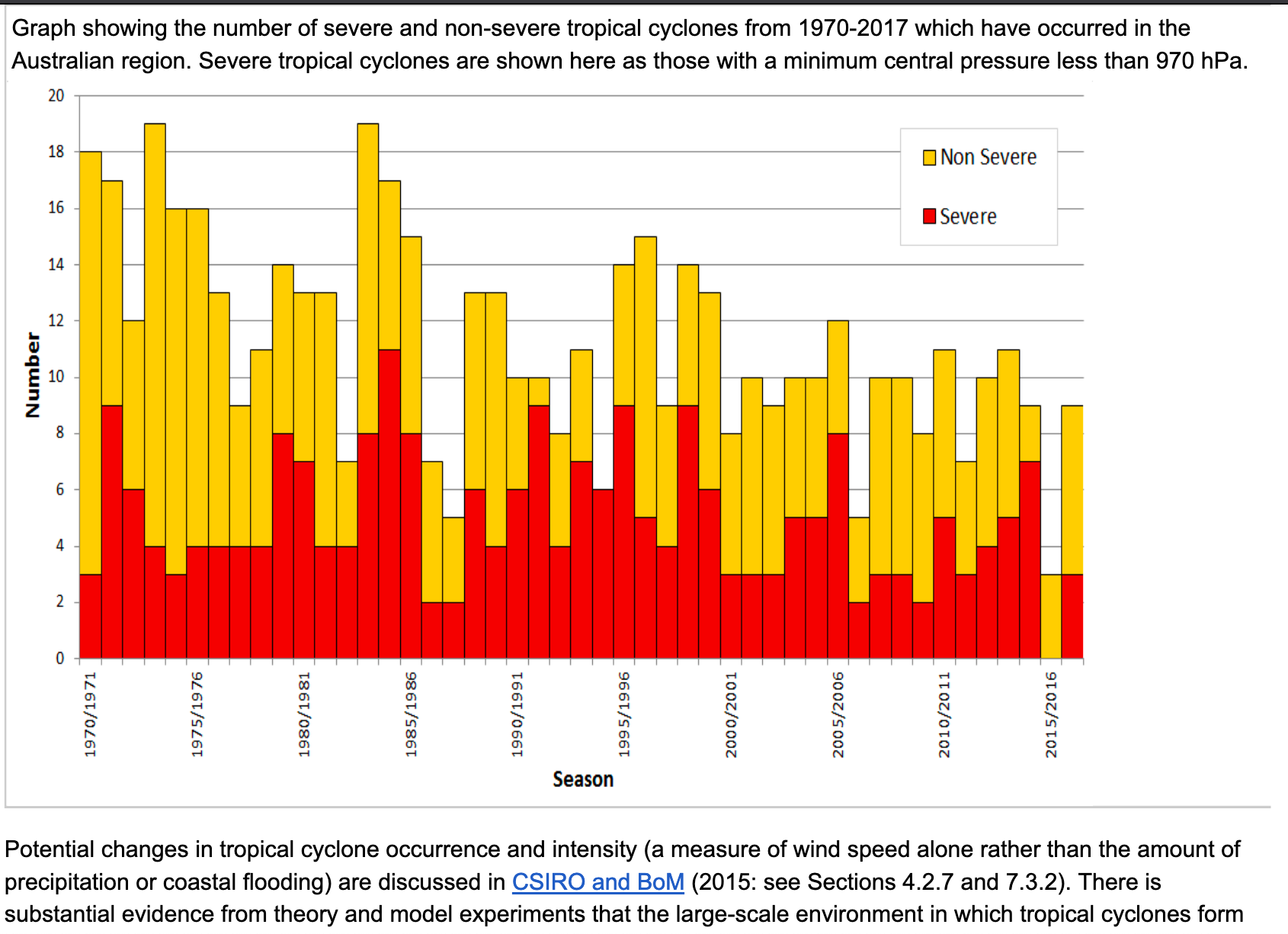
Coral bleaching events tend to be cyclical and coincide with periods of exceptionally low sea levels. The dramatic falls in sea level across the western Pacific Ocean in 2016 are charted on page 267 (chapter 17) of a book I edited, ‘Climate Change: The Facts 2020′.
The dramatic falls in sea level were associated with an El Nino event. These have been documented at the Great Barrier Reef back 3,000 years by Helen McGregor at Wollongong University. I’m specifically thinking of her paper entitled ‘Coral micro atoll reconstructions of El Nino-Southern Oscillation: New windows on seasonal and inter annual processes’, which was published in the journal ‘Past Global Changes’ (volume 21) in 2013.
I was born and bred in northern Australia. The Great Barrier Reef is a second home, and for me the most awe-inspiring natural environment on Earth.
My mother lived and worked on Heron Island at the Great Barrier Reef in 1955. That was the same year the young Bob Endean established the University of Queensland Heron Island Research Station. He went on to become a famous marine biologist, and instrumental in the formation of the Great Barrier Reef Marine Park Authority (GBRMPA) in 1975. According to Endean’s research the Great Barrier Reef was almost always just about to be destroyed by crown-of-thorn starfish.
There is a photograph of my mother, then Joan Edith Pearce, standing knee deep surrounded by Porites coral micro atolls that are stunted and bleached. But Mum, who turns 90 next March, said there was no talk of bleaching back then, everyone was fearful of the starfish.
It is the case that back then and until recently, coral calcification rates were calculated based on coring of the large Porites corals. By dissecting micro-atolls — the type shown in the picture of my mother at Heron Island back in 1955 — it is possible to understand that sea level has been a constraint to coral growth at the Great Barrier reef for at least this long: at least 3,000 years. There is no evidence of overall sea level rise, there is evidence that sea levels have fallen 1.5 metre since the Holocene High Stand.
Corals are animals, closely related to jelly fish, but they differ in having a limestone skeleton. This is hard-stuff, calcium carbonate, and it can persist in the environment and provide an indication of changes in sea level, and also the growth rates of corals, over thousands of years.
There are well established techniques for coring the Porites corals, and then measuring growth rates. But since 2005 the Australian Institute of Marine Science has stopped using this technique to measure how well corals are growing at the Great Barrier Reef. The few studies still using the old technique suggest that as would be expected, as water temperatures have increased marginally, coral growth rates have also increased.
But rather than admit this fact that runs contrary to the zeitgeist, leading research institutions have moved from such direct measures to new and complicated ‘proxies’ – they thus have more flexibility in what they ‘find’ because the measurement is no-longer something that actually represents coral growth rates or coral cover. A proxy vote, for examples, is something delegated. This gives the researchers at James Cook University the potential to generate what might be considered policy-based evidence.
Real science is about actual measurements of real phenomena, and real world observations.
A conclusion in the media reporting of the most recent research is that “there is no time to lose, we must sharply decrease greenhouse gas emissions”. Another assumption, perhaps inadvertently created with bias and agenda. Though, this is not even written into the article. Rather it is reported in the media associated with the article just published by London’s Royal Society. It is assumed. It is also assumed that the corals at North Direction island never recovered from the cyclones and bleaching – yet they have recovered! The coral reefs across this region are magnificent right now, and this can be verified by diving them with one’s eyes wide open.
The Great Barrier Reef is resilient, and individual reefs, including the reefs at North Direction Island, do recover. As I explain in my new short documentary film, the huge colony of Pavona clavus known as The Monolith, that stretches about 30 metres up the limestone ridge at Ribbon Reef No 10, has already endured countless cyclones and bleaching events – it is a survivor.
The Great Barrier Reef as one ecosystem, comprises nearly 3,000 individual reefs stretching for 2,000 kilometres. It is still visible from outer space.
Damaged areas can always be found somewhere because a coral reef that is mature and spectacular today, may be smashed by a cyclone tomorrow.
If we are to accurately measure coral cover, and coral growth rates, then the cycles need to be considered. The methodology used to assess the health of the Great Barrier Reef should be based on direct measures (not proxies), it should be over a reasonable time span understanding that there are regular bleaching events every 18.6 years corresponding with the lunar declination cycle, and it should include a large number of coral reefs.
When we are able to move beyond ‘postmodern science’, only then will what be written in the most prestigious journals correspond with what I see in the real world.
Oh, how I love jumping off boats and going under the water at the Great Barrier Reef where there are still colourful corals and such curious fish.
It is a pity that the make believe in the science journals creates so much fear and anxiety about something that is still so beautiful and magical.
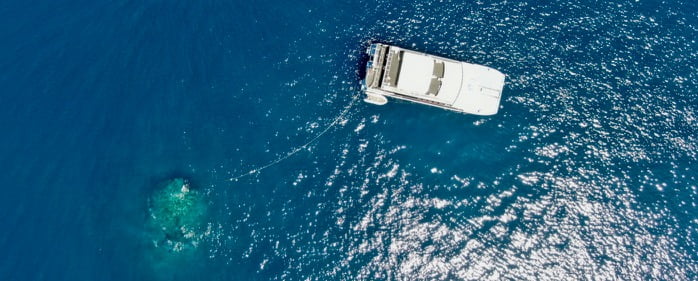
____
*The new article claiming half the corals are dead is:
Dietzel A, Bode M, Connolly SR, Hughes TP. 2020 Long-term shifts in the colony size structure of coral populations along the Great Barrier Reef. Proc. R. Soc. B 287: 20201432. http://dx.doi.org/10.1098/rspb.2020.1432

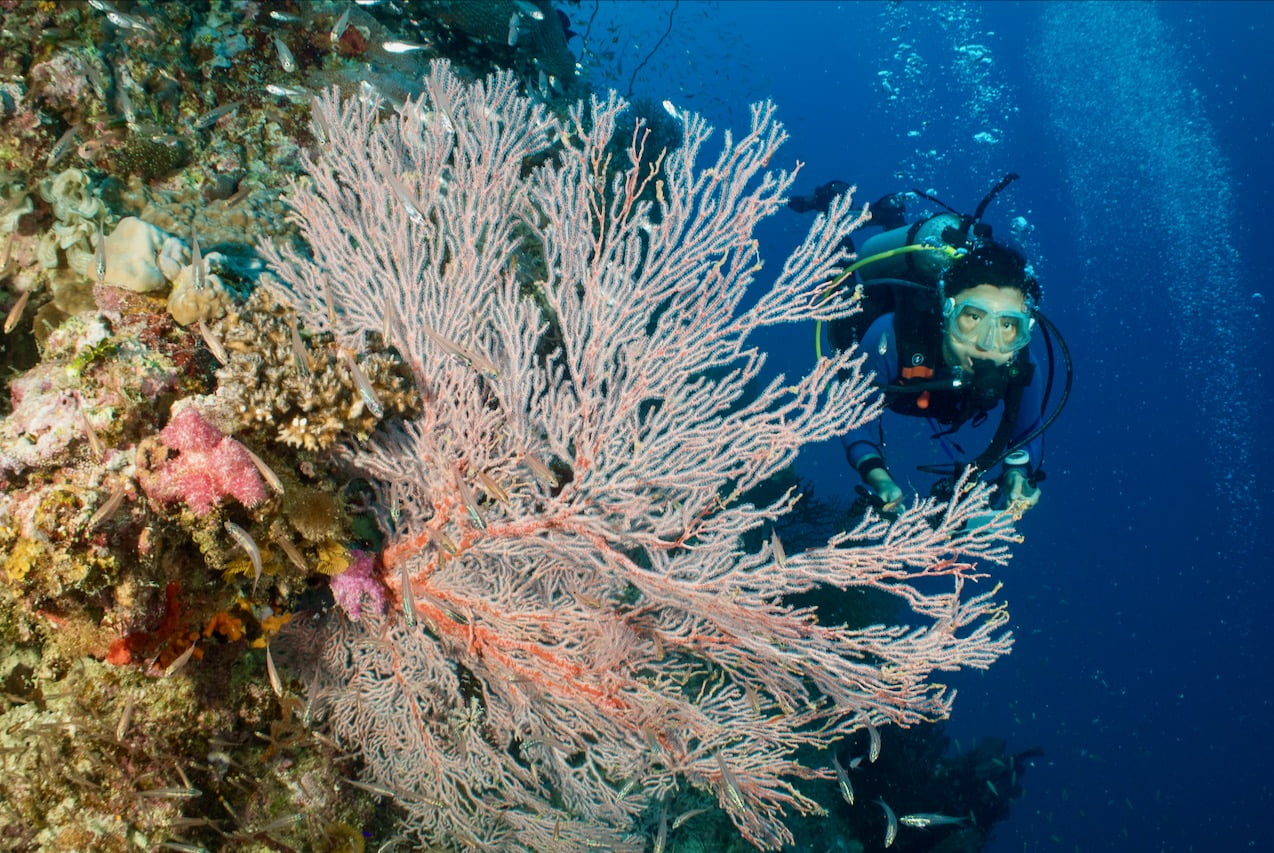
 Jennifer Marohasy BSc PhD is a critical thinker with expertise in the scientific method.
Jennifer Marohasy BSc PhD is a critical thinker with expertise in the scientific method.

Wonderful article Jennifer.If you get any comment from the ABC they will no doubt refer to the godfather of the GBR….MR C Veron no less
Again Jennifer, your refutation of the baloney from these desktop scientists shows just how unscientific the world has become.
Presumably, you’ve sent all your data to these wayward beings, and their publishers, so that they can’t deny they have the facts, even though they may not want to embarass themselves with the truth lest they lose their government stipends, aka grants.
SCIENCE – Stupid Clumbsy Imbeciles Emulating Nonsensensical Claims Everywhere
The other thing of course, is “Perspective”.
The “living” part of coral is, essentially, a wafer thin layer of polyps that form the “skin” of a reef.
EVERYTHING else inside a reef structure is DEAD minerals.
EVERY bit of coal at depths below suitable sunlight and nutrient levels is DEAD. Why do divers encounter “dead” coral at 60 feet and more? Not enough light, for starters. How did huge masses of coral then form at such depths and even greater?
They DIDN’T.
The seabed sank or the oceans rose, or BOTH. The process (either one) usually happens at a pace that allows the coral beasties to build UP, to maintain their lifestyle.
Of course, next Ice-Age, they are all stuffed as the sea level will steadily go DOWN as more water is frozen at the poles each year. Ice Ages tentd to have a rapid onset, often less trhan a Century, and extended ‘recovery”, 500 to a couple of thousand years. See also Solar cycles and Albedo. Combine an extended solar “minimum and a a planet half covered in shiny, white, ice and snow and it will be pretty ugly for a LONG time.
The Gaia-botherers need to have a serious chat with the Rock Doctors. The planet’s crust is a VERY lively bunch of rocks, floating on some seriously hot molten stuff below.
Nothing is set in geological Aspic.
Then, there’s always politics.
Your excellent analysis of the state of the Great Barrier Reef confirms the consensus opinion of proper and professional scientists and again lays bare the politically motivated junk reports of people playing at trying to be scientists. Your coral reef films with commentary need to be circulated widely on the internet to inform viewers of the true state of affairs regarding the GBR with emphasis on your film evidence versus the junk reports which are wild claims which cannot be replicated in real life.
But I thought it was a Center of Excellence?
Center of Excrescence?
Thank you, Jennifer, for once again investigating the nonsensical claims by the coral-demise-propaganda community and showing how wrong those claims are.
Regards,
Bob
PS: Stay safe and healthy, all.
Thanks again, Jen, for this very timely posting.
The Washington Post has also been pushing this drivel:
https://www.washingtonpost.com/climate-environment/2020/10/13/warming-has-killed-half-coral-great-barrier-reef-study-finds-it-might-never-recover/
Jeff Bezos, the founder of Amazon and the world’s richest man, has recently purchased the Washington Post newspaper, a virulently anti-Trump publication that has not become less anti-Trump under its new ownership.
Trump has responded by suggesting that Amazon is ripping off the Postal Service by not paying enough for its package deliveries. If Trump is reelected, Bezos may have to start currying favor rather than promoting Trump hatred..
Amazon’s 2019 annual report is heavy with climate change, carbon footprints and renewable energy.
https://www.americanthinker.com/articles/2020/10/jeff_bezos_and_amazon_join_the_religion_of_greeen.html
Sorry about that WaPo double-up, Jen. I somehow thought your story was from one of the other many green groan reports.
They have all been unscientifically groaning about it.
Just a personal note thanking you for bringing back great memories of scuba diving on the Great Barrier reef.
I’ve dived in the remotest places in the Manua Islands, Somoa, Tonga, and all throughout the Caribbean. Nothing compares to the majesty of the Great Barrier Reef!
Received by email and filing this here:
My name is Malcolm Munro,my nick name is Darby,which most people know me by.I am 81 years old,I went to Heron Island in either 1963 or 1964,I left Heron Island in November 1969 and skippered the KARILAR X Norman Wright boat for Waller Muller for about 2 years.
Fishing the Swains Reefs.I then went and worked tugs at Hay Point and then went to Hayman Isand for 3 years, doing fishing trips for guests.I left Hayman,went back to the tugs for the 2nd stage of Hay Point. I finished doing a few more things,I was very good friends with Robert Paulson,BOB,whose family had owned Heron Island,and I had a small boat and Bob Poulson got me a job suppling Heron Island with fish my wife and 2 young kids lived at Heron at this time. I just wrote all this so you could have some idea of who I am, was. I have also driven a dive boat out of Cairns for Peter Tibbs and Allan Southwood for a few years.
While I was at Heron in the 60 Howard Choat was doing his PHD,he went to New Zealand and then finished up at Townsville,at Heron he was studying parrot fish and I used to dive with him of a night time,I have done a lot of diving. So what this letter is about is I agree with you that there is nothing wrong with the reef, about 12 years ago I went over to Heron as a guest and dived on the bombi there it is as good now as it was in the 60s,I am friendly with 2 families that run charter boats from Gladstone to the Swains for 7 days, they are catching MORE fish this year than their fathers did years ago,I prawn trawlered for years as I got older,this year on the east coast of QLD and the Torres Straits they are catching more prawns than ever.Howard Choat did his PHD at Heron Island when I was there I used to go diving of a night time with him when I could,he was studying parrot fish,they sleep of a night time. Anyway if this could interest you I will give you my phone number.
I don’t know if you have been to RAINE ISLAND, they have bulldozed the dam place and recked the place, you should do some thing about that.
So much thanks to Charles Rotter for republishing this article at WUWT:
https://wattsupwiththat.com/2020/10/15/half-the-corals-dead-but-not-in-real-life/
Back in 2012, Professor Hughes was convener of the 12th International Coral Reef Symposium (ICRS) in Cairns (co-hosted by the ARC Centre of Excellence for Coral Reef Studies and James Cook University), wherein thousands from some 80 countries enjoyed a lovely 5-day venue including field trips. Taking it in six steps:
Step 1) Beforehand, three eminent scientists including the convener gathered at Stanford and drafted the consensus.
Step 2) They also launched an endorsement-form on their websites at COS (Centre for Ocean Solutions) and ICRS which although aimed at scientists could be actioned by the unqualified without any affiliations other than their hometown name.
Step 3) They also made the following request on the COS and ICRS websites: “To build a large base of support in preparation for the pubic launch of the statement (during the opening ceremony of the 12thInternational Coral Reef Symposium on July 9, in Cairns, Australia), please click HERE to join other scientists from around the world by adding your name to the list of endorsees.”
Step 4) The ICRS website published a list of almost 2,500 endorsees dated 6/July/2012 that being three days before the five-day symposium started.
Step 5) The consensus statement launched at the opening ceremony and various sympathetic press reports announced that over 2,000; 2,200; 2,400 or 2,500 scientists had endorsed the alarmism, depending on source.
Step 6) Convener announces success of the Symposium (This is fun) http://www.icrs2012.com/Default.htm#farewell) and the return home of 2,000 (two thousand) “of us” to 80 countries. Also a plea to continue endorsing the consensus statement….. more than 3,000 signatures so far and we would like to keep the momentum going.
More detail and links at https://wattsupwiththat.com/2012/07/25/six-easy-steps-for-saving-the-coral-reefs-for-our-grandchildren/
Compare info back then with now:
Back in early April the ABC (Australian national broadcaster) and others hyperventilated over reports of the worst-ever GBR bleaching (and catastrophically the third mass event in only five years; to be the new norm).
Professor Hughes (the director of the Australian Research Council Centre of Excellence for Coral Reef Studies at James Cook University) was quoted globally, my bold and [adds] e.g.:
The ABC online:
https://www.abc.net.au/news/2020-04-07/great-barrier-reef-most-widespread-coral-bleaching-on-record/12107054
“The southern bleaching was very severe and we were most concerned about the south because of the naivete of the corals that are there,” he said.
…Terry Hughes spent nine days surveying 10,000 kilometres of the reef [Imagine the logistical difficulties in making SUBJECTIVE assessments and data compilations in a fixed-wing aircraft in Hughes’ selection preferences among the over 2,900 individual reefs and 900 islands]. https://en.wikipedia.org/wiki/Great_Barrier_Reef
“They hadn’t bleached before, which means there are more corals and more of the corals that are particularly susceptible to heat stress,” he said…
In the last two bleaching events in 2016 and 2017, about half the coral on the Great Barrier Reef was estimated to have died…
…Bleaching in 2016 was more severe than 2020, but was concentrated in the north of the Great Barrier Reef.
In those events, the areas hit hardest were in the remote northern stretches of the reef… The southern and central reef had mostly been spared. This time those parts were not so lucky…
“For the first time, the Barrier Reef has bleached in all three major regions: in the north, in the central region and in the southern regions,” Professor Hughes said…
The New York Times:
https://www.nytimes.com/2020/04/06/world/australia/great-barrier-reefs-bleaching-dying.html
…The reef was being ravaged by bleaching yet again [after the 50% mortality in 2016 and 2017], this time across an even wider area.
“It’s the first time we’ve seen severely bleached reefs along the whole length of the reef, in particular, the coastal reefs,” said Professor Hughes… …“Those are bleached everywhere.”
The survey amounts to an updated X-ray for a dying patient, with the markers of illness being the telltale white of coral that has lost its color, visible from the air and in the water.
The mass bleaching indicates that corals are under intense stress from the waters around them, which have been growing increasingly hotter.
The world’s oceans, which absorb 93 percent of the heat trapped by the greenhouse gases that humans send into the atmosphere by burning fossil fuels, are warming up 40 percent faster on average than scientists estimated six years ago.
So, what does the Australian government’s GBRMPA (Great Barrier Reef Marine Park Authority) latest report say today? http://www.gbrmpa.gov.au/the-reef/reef-health
Coral bleaching and disease: Our Eye on the Reef network reported isolated instances of low severity coral bleaching and damage in all management areas. Isolated instances of low severity coral disease were reported from all areas, except the Far Northern management area.
Crown-of-thorns starfish: Crown-of-thorns starfish outbreaks continue to impact reef health across all management areas.
Earlier GBRMPA (and AIMS) reports also dismantle some of the specific claims for the southern region, particularly Heron Island’s allegedly “first ever event”.
The impunity with which the catastrophic narrative is advanced despite the lack of data is profoundly disturbing.
Please keep up a no d don’t stop your factual narrative.
Hi Jennifer
love your work
I seem to remember the GBR coral spawning last year was described as prolific.
If corals are being reduced, I would have thought the coral spawning events would also be reduced
Question: Is there a database of coral spawning from say 1980 to 2020
More data leads to better answers
yours Stephen